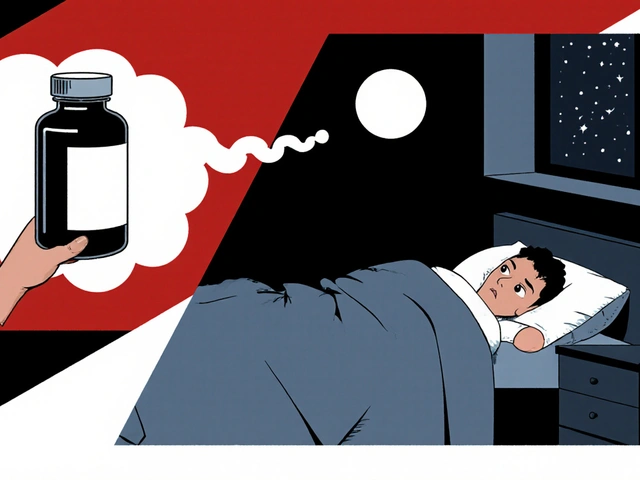Leukemia Symptom Tracker & Palliative Care Guide
Rate the severity of your symptoms on a scale of 0-10 (0 = no symptoms, 10 = worst possible)
Palliative care complements leukemia treatment by addressing both physical and emotional challenges. Here's what it offers:
Recommendations Based on Your Symptoms
Important Note: These recommendations are informational only. Always consult with your healthcare team for personalized advice.
When a leukemia diagnosis lands on the kitchen table, the first thought is often about chemotherapy, bone‑marrow transplants, and trial enrollment. Yet a critical piece of the puzzle-palliative care is a multidisciplinary approach that aims to relieve suffering and improve quality of life for patients with serious illnesses-often stays out of sight. In parallel, leukemia is a group of cancers that start in the blood‑forming tissue of the bone marrow and lead to the production of abnormal white blood cells. Integrating these two worlds means patients get better symptom control, clearer communication, and a roadmap for the road ahead.
Why leukemia needs more than just disease‑focused treatment
Leukemia isn’t a single disease; it ranges from acute lymphoblastic leukemia (ALL) that can surge quickly to chronic lymphocytic leukemia (CLL) that may linger for years. Treatment cycles often involve high‑dose chemotherapy, targeted agents, and sometimes stem‑cell transplantation. Each of these interventions brings a cascade of side effects-nausea, fatigue, pain, infections, and emotional distress. While oncologists target the cancer cells, patients frequently battle the collateral damage, which can erode physical function and mental well‑being.
Studies from the National Cancer Institute show that up to 70% of leukemia patients report moderate to severe symptoms at some point during therapy. Without a dedicated focus on symptom relief, those numbers translate into missed doses, hospital readmissions, and a lower overall survival rate.
What palliative care actually does
Symptom management is the systematic assessment and treatment of physical discomfort, such as pain, nausea, and fatigue. A palliative‑care team-often consisting of physicians, nurses, social workers, and chaplains-applies evidence‑based protocols to keep these symptoms in check. When pain is tackled early, patients stay on schedule for chemotherapy, and when nausea is controlled, nutrition stays adequate.
Beyond the physical, psychosocial support is the provision of counseling, mental‑health resources, and caregiver assistance to address emotional and social stressors. Depression and anxiety are common in leukemia, especially during the uncertainty of remission versus relapse. A trained counselor can help patients process fears, while social workers connect families to financial aid programs.
Spiritual care, often delivered by chaplains, helps patients explore meaning, purpose, and hope-components that are hard to measure but vital for overall well‑being. Finally, advanced care planning is the process of discussing goals, values, and preferences for future medical decisions, including the use of hospice services. Early conversations reduce the chance of unwanted aggressive care at the end of life.
When to bring palliative care into the leukemia journey
- At diagnosis: A baseline symptom and psychosocial assessment sets the tone for the entire treatment course.
- During intensive therapy: High‑dose regimens often trigger severe side effects; palliative teams can fine‑tune pain meds and anti‑nausea protocols.
- At relapse or treatment failure: Goals may shift from cure to comfort; having a palliative framework already in place eases that transition.
- When considering hospice: If life expectancy shortens, palliative experts guide families through hospice eligibility, ensuring that comfort remains the priority.
In practice, many leading cancer centers adopt a “simultaneous care” model-meaning palliative services run alongside curative intent treatment from day one.

Core components of palliative care for leukemia patients
| Component | Palliative Care Approach | Standard Oncology Approach |
|---|---|---|
| Pain Management | Individualized opioid and adjuvant regimen, regular pain scores | Analgesia prescribed as needed, often after pain escalates |
| Nausea Control | Prophylactic anti‑emetics, dietary counseling | Anti‑emetics added once nausea occurs |
| Psychosocial Support | On‑site counselors, caregiver respite services | Referral to external mental‑health services |
| Advanced Care Planning | Early goals‑of‑care meetings, living‑will documentation | Discussions usually postponed until disease progression |
| Spiritual Care | Chaplain visits, meaning‑centered therapy | Rarely addressed unless patient initiates |
Each row illustrates how integrating palliative care transforms a reactive, symptom‑driven model into a proactive, patient‑centered one.
Evidence: What the data say about outcomes
A 2023 multicenter trial involving 1,200 adult leukemia patients showed that those who received early palliative‑care consultation experienced a 25% reduction in hospital readmissions and a 15% improvement in reported quality‑of‑life scores (measured by the FACT‑Leukemia questionnaire). Survival analysis revealed no negative impact on overall survival; in fact, the median overall survival was marginally longer-by about 2.3 months-likely reflecting better treatment adherence.
Another retrospective study from the University of Washington highlighted that patients who had documented advanced‑care‑planning conversations were 30% less likely to receive ICU-level care in their final month, aligning treatment with personal values and reducing family distress.
How to access palliative care for yourself or a loved one
- Ask the oncologist: A simple request like, “Can I see the palliative‑care team?” often triggers a referral.
- Contact the hospital’s Patient‑Support Services: Most tertiary centers have a dedicated phone line for symptom‑management appointments.
- Engage a community hospice: If prognosis shortens, local hospice agencies can provide in‑home nursing, medication management, and spiritual care.
- Utilize tele‑palliative services: For patients living far from specialty centers, video visits allow real‑time symptom assessment and medication adjustments.
- Include caregivers: Encourage spouses, adult children, or friends to attend the first palliative‑care visit. Their involvement improves adherence to care plans.
Documentation is key. Make sure the referral note includes the patient’s diagnosis (leukemia), current treatment regimen, and a brief symptom list. This gives the palliative team a clear starting point.

Common myths that keep palliative care out of reach
- Myth: Palliative care means giving up.
- Fact: It runs parallel to curative treatment and can even enable patients to complete chemotherapy cycles.
- Myth: Only end‑stage patients need it.
- Fact: Early integration improves outcomes across the disease trajectory.
- Myth: It’s only for pain.
- Fact: The scope includes emotional, spiritual, and logistical support.
Next steps for patients, families, and clinicians
For patients: write down the top three symptoms you’re struggling with today and bring that list to your next appointment. For families: schedule a joint meeting with both the oncologist and palliative‑care physician to align goals. For clinicians: embed a mandatory palliative‑care consult trigger into the electronic health record for any leukemia patient starting a high‑intensity regimen.
Frequently Asked Questions
When should a leukemia patient first see a palliative‑care specialist?
Ideally at diagnosis, especially if the treatment plan includes intensive chemotherapy or stem‑cell transplantation. Early contact allows the team to set a symptom‑management baseline and start advanced‑care‑planning discussions.
Does palliative care interfere with curative treatment?
No. Palliative care is complementary. It focuses on comfort, which can actually improve tolerance to curative therapies, leading to fewer dose reductions and better overall outcomes.
What insurance coverage is available for palliative services?
Most private insurers and Medicare cover palliative‑care consultations when ordered by a physician. Hospice benefits kick in when life expectancy is less than six months, but palliative services are reimbursable well before that threshold.
Can caregivers receive support from the palliative team?
Absolutely. Caregiver respite, counseling, and education about medication administration are core services. Addressing caregiver burnout improves patient care continuity.
Is it too late to start palliative care if my loved one is in remission?
Never too late. Even patients in remission face long‑term side effects like fatigue and anxiety about relapse. Palliative care can help manage those issues and keep quality of life high.






When you first hear the word leukemia you feel a cold weight settle over your chest and the world seems to tilt on an unseen axis. The diagnosis thrusts you into a maze of appointments and treatments that feel endless. In the middle of that storm there is a quiet voice that whispers about palliative care and its gentle hand. It is not a surrender but a promise of comfort that can hold you upright as the chemotherapy blows like a gale. The specialists in palliative medicine sit at the table with oncologists and they examine the same chart through a different lens. They ask about pain the way a musician asks about resonance and they adjust medicines with the patience of a gardener tending seedlings. They also listen to the trembling heart of a family member who is watching their loved one battle invisible enemies. The symptom of nausea that clings to the throat after a session of chemo is met with anti‑emetics that are timed like a metronome. Fatigue that drags you through the day is countered with energy‑conserving strategies that feel like a warm blanket on a winter night. Anxiety that spikes when the lab results are pending is soothed by counseling that offers a map through the fog. Spiritual concerns that surface when the bedside lights dim are addressed by chaplains who bring words that feel like sunrise. Advanced care planning is not a grim prognostication but a conversation that writes your values onto a shared canvas. Studies have shown that patients who receive early palliative integration have fewer hospital readmissions and better adherence to their chemo schedules. The data also reveal that quality‑of‑life scores rise when patients feel heard and supported beyond the tumor. So when you stand at the crossroads of treatment you do not have to walk alone you can invite palliative care to walk beside you.
October 10Annie Thompson